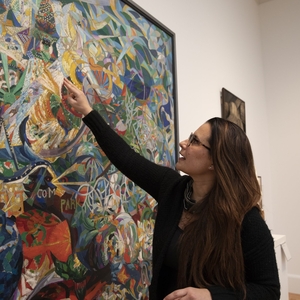Photograph by Jessica Smolinski, Yale University Art Gallery
At a Glance
- Support student learning by incorporating the collections & artifacts at Yale’s museums and libraries.
- Yale’s vast collections offer hands-on, multimodal learning experiences that deepen student engagement, spark cross-disciplinary connections, and encourage critical inquiry beyond textbook learning.
- Collections support a wide range of disciplines—from environmental studies and physics to medicine—helping students develop skills like empathy, critical observation, and perspective-taking.
- Encounters with physical objects promote visual literacy, analytical thinking, and comfort with ambiguity—skills that are transferable beyond the classroom.
- In contrast to digital information, in-person interaction with original objects encourages slow, embodied, and authentic learning experiences.
- Yale’s museum and library staff offer expert guidance and tailored class visits, making collections accessible for one-time use or as a foundation for entire courses.
Spanning millennia and numbering millions of objects, Yale University’s collections constitute an unparalleled cultural and educational resource. Beyond their use in scholarship, research, and creative work, collections play an important role in teaching and learning on campus. First-hand encounters with original works of art and primary source materials offer a different learning modality and an exciting learning environment that together deepen student engagement with course content, while also sparking connections across disciplines, cultures, and concepts. Through their tangible presence and material and aesthetic characteristics, Yale’s unique collections can convey information, engage the imagination, and provoke questions in ways no textbook could. Furthermore, teaching with collections can cultivate transferable skills and thinking dispositions such as visual and material literacies, perspective-taking, and grappling with ambiguity that can serve students beyond graduation. Jim Harris gave a recent recorded talk on learning with objects in university collections
With their exceptional depth and breadth, Yale’s museum and library collections support a wide variety of subject areas, interests, and goals across the curriculum. For example:
- Students in the School of the Environment can study maps and photographs to document a changing landscape.
- A physics class can ponder the forces keeping a modernist statue upright or explore how notions of time and space differ across cultures.
- Medical students can hone their critical observation skills or cultivate empathy in front of a painting.
- All disciplines can wonder at the complexity of human history, as well as the limitations inherent in the collected byproducts of human activity.

As learning increasingly relies on virtual sources and the rapid retrieval of information from the internet, slow and close in-person interactions with collections help students to engage in authentic and embodied ways with an object’s physical reality and thus to understand the real as distinctly different from the virtual. For more examples from STEM fields, see the recent publication STEM in the Art Museum: Innovative Pedagogies for the 21st-Century University and the recordings of our Fall 2022 STEM in the Museum event, which inspired the publication.
Yale’s cultural heritage institutions concentrate both extraordinary curatorial expertise and highly trained museum and library staff who provide intellectual and physical access to the collections and ensure an active and diverse learning experience for students. We invite instructors of all ranks and from all disciplines to consider bringing their classes to Yale’s collections, as a single visit to shake up classroom routines or reinvigorate conversations with new ideas, a series of visits correlated with course content and learning outcomes, or even an entire course based in our repositories.
To learn more about Yale’s collections, to schedule a consultation about the specifics of integrating collections into your teaching, or to book a class visit, contact the respective institution at the email address provided below.

“I teach with the YUAG’s art collection in my classes of law and political economy in the Program on Ethics, Politics, and Economics as a way to promote visual intelligence and critical thinking, while fostering respectful debates.”
Ximena Benavides, Lecturer & Postdoctoral Associate, Political Science and Yale Law School
Library and Museum Collections
To explore the possibilities across all of Yale’s museums, libraries, and archives, visit LUX, a digital platform that offers a unified search of Yale’s cultural heritage holdings. For support in using the digital platform, check out the LUX content search FAQs or Ask Yale Library.
Library Collections
- Arts Library Special Collections, Robert B. Haas Family Arts Library
- email: haasalsc@yale.edu
- Beinecke Rare Book & Manuscript Library (including Manuscripts and Archives)
- email: beinecke.education@yale.edu
- Area Studies and Humanities
- Irving S. Gilmore Music Library
- email: musiclibrary@yale.edu (instruction program)
- email: musicspecialcollections@yale.edu
- The Lewis Walpole Library
- email: walpole@yale.edu
- Marx Science and Social Science Library
- email: kelly.blanchat@yale.edu
- Medical Historical Library (part of Harvey Cushing/John Hay Whitney Medical Library)
- email: historical.library@yale.edu
- Yale Film Archive
Museum Collections

Downloads
To learn more about teaching at the Yale University Art Gallery, see this overview document to plan your visit.
-
Audience
-
Category
